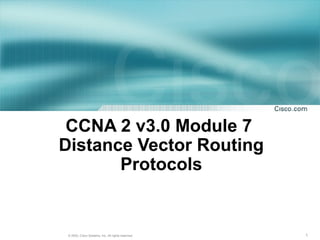Ccna2v3 mod07
- 1. 1ÂĐ 2003, Cisco Systems, Inc. All rights reserved. CCNA 2 v3.0 Module 7 Distance Vector Routing Protocols
- 2. 222ÂĐ 2003, Cisco Systems, Inc. All rights reserved. Purpose of This PowerPoint âĒ This PowerPoint primarily consists of the Target Indicators (TIs) of this module in CCNA version 3.0. âĒ It was created to give instructors a PowerPoint to take and modify as their own. âĒ This PowerPoint is: NOT a study guide for the module final assessment. NOT a study guide for the CCNA certification exam. âĒ Please report any mistakes you find in this PowerPoint by using the Academy Connection Help link.
- 3. 333ÂĐ 2003, Cisco Systems, Inc. All rights reserved. To Locate Instructional Resource Materials on Academy Connection: âĒ Go to the Community FTP Center to locate materials created by the instructor community âĒ Go to the Tools section âĒ Go to the Alpha Preview section âĒ Go to the Community link under Resources âĒ See the resources available on the Class home page for classes you are offering âĒ Search http://www.cisco.com âĒ Contact your parent academy!
- 4. 444ÂĐ 2003, Cisco Systems, Inc. All rights reserved. Objectives âĒ Distance vector routing âĒ RIP âĒ IGRP
- 5. 555ÂĐ 2003, Cisco Systems, Inc. All rights reserved. Distance Vector Updates
- 6. 666ÂĐ 2003, Cisco Systems, Inc. All rights reserved. Problem: Routing Loops âĒ Routing loops can occur when inconsistent routing tables are not updated due to slow convergence in a changing network.
- 7. 777ÂĐ 2003, Cisco Systems, Inc. All rights reserved. Problem: Counting to Infinity
- 8. 888ÂĐ 2003, Cisco Systems, Inc. All rights reserved. Solution: Defining a Maximum for Infinity
- 9. 999ÂĐ 2003, Cisco Systems, Inc. All rights reserved. Solution: Split Horizon
- 10. 101010ÂĐ 2003, Cisco Systems, Inc. All rights reserved. Solution: Route Poisoning
- 11. 111111ÂĐ 2003, Cisco Systems, Inc. All rights reserved. Solution: Triggered Updates
- 12. 121212ÂĐ 2003, Cisco Systems, Inc. All rights reserved. Solution: Holddown Timers
- 13. 131313ÂĐ 2003, Cisco Systems, Inc. All rights reserved. Key Characteristics of RIP
- 14. 141414ÂĐ 2003, Cisco Systems, Inc. All rights reserved. RIP Commands âĒ Using router rip and network commands to Enable RIP âĒ Enabling RIP on an IP-addressed network âĒ Monitoring IP packet flow using the show ip protocol command âĒ The show ip route command
- 15. 151515ÂĐ 2003, Cisco Systems, Inc. All rights reserved. Configuring RIP
- 16. 161616ÂĐ 2003, Cisco Systems, Inc. All rights reserved. Using the ip classless Command
- 17. 171717ÂĐ 2003, Cisco Systems, Inc. All rights reserved. RIP Configuration Issues âĒ To reduce routing loops and counting to infinity, RIP uses the following: Defining infinity Split horizon Route poisoning & poison reverse Triggered updates Holddown timers
- 18. 181818ÂĐ 2003, Cisco Systems, Inc. All rights reserved. The show ip protocols Command
- 19. 191919ÂĐ 2003, Cisco Systems, Inc. All rights reserved. The show ip route Command
- 20. 202020ÂĐ 2003, Cisco Systems, Inc. All rights reserved. Troubleshooting RIP Update Issues âĒ debug ip rip âĒ show ip rip database âĒ show ip protocols {summary} âĒ show ip route âĒ debug ip rip {events} âĒ show ip interface brief
- 21. 212121ÂĐ 2003, Cisco Systems, Inc. All rights reserved. Preventing Routing Updates through an Interface
- 22. 222222ÂĐ 2003, Cisco Systems, Inc. All rights reserved. Load Balancing with RIP
- 23. 232323ÂĐ 2003, Cisco Systems, Inc. All rights reserved. Administrative Distance
- 24. 242424ÂĐ 2003, Cisco Systems, Inc. All rights reserved. Integrating Static Route with RIP âĒ A router running RIP can receive a default route via an update from another router running RIP. âĒ Another option is for the router to generate the default route itself. âĒ The administrator can override a static route with dynamic routing information by adjusting the administrative distance values.
- 25. 252525ÂĐ 2003, Cisco Systems, Inc. All rights reserved. IGRP Features
- 26. 262626ÂĐ 2003, Cisco Systems, Inc. All rights reserved. IGRP Commands âĒ Using router igrp and network commands to enable IGRP âĒ Enabling IGRP on an IP-addressed network âĒ Monitoring IP packet flow using the show ip protocol command âĒ The show ip interfaces command âĒ The show ip route command âĒ The debug ip rip command
- 27. 272727ÂĐ 2003, Cisco Systems, Inc. All rights reserved. IGRP Metrics âĒ Bandwidth â The lowest bandwidth value in the path âĒ Delay â The cumulative interface delay along the path âĒ Reliability â The reliability on the link towards the destination as determined by the exchange of keepalives âĒ Load â The load on a link towards the destination based on bits per second
- 28. 282828ÂĐ 2003, Cisco Systems, Inc. All rights reserved. IGRP Routes: Interior, System, & Exterior
- 29. 292929ÂĐ 2003, Cisco Systems, Inc. All rights reserved. IGRP Stability Features âĒ Holddowns, Split horizons, & Poison-reverse updates
- 30. 303030ÂĐ 2003, Cisco Systems, Inc. All rights reserved. Configuring IGRP
- 31. 313131ÂĐ 2003, Cisco Systems, Inc. All rights reserved. Migrating RIP to IGRP 1. Verify existing routing protocol (RIP) on the routers to be converted. 2. Configure IGRP on RouterA and RouterB 3. Enter show ip protocols on RouterA and RouterB 4. Enter show ip route on RouterA and RouterB
- 32. 323232ÂĐ 2003, Cisco Systems, Inc. All rights reserved. Verifying IGRP Configuration âĒ Some commands for checking IGRP configuration are as follows: show interface interface show running-config show running-config interface interface show running-config | begin interface interface show running-config | begin igrp show ip protocols
- 33. 333333ÂĐ 2003, Cisco Systems, Inc. All rights reserved. Troubleshooting IGRP âĒ The following commands are useful when troubleshooting IGRP: show ip protocols {summary} show ip route debug ip igrp events IGRP protocol events debug ip igrp transactions IGRP protocol transactions ping traceroute

































